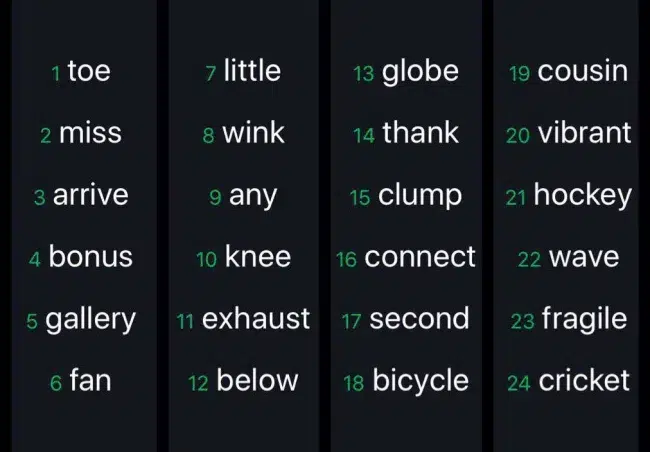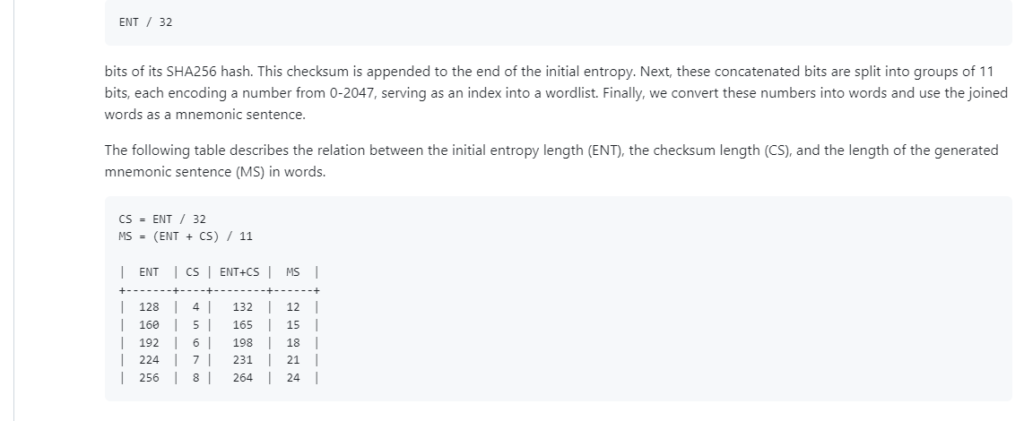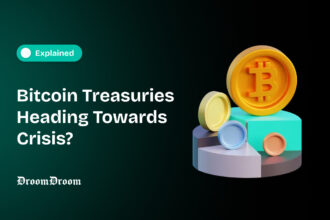Security in the cryptocurrency space is something to pay attention to. With the crypto market worth more than $1 trillion, users need to safeguard their assets dearly from frauds and hackers; some ideal ways to do this are through mnemonic phrases and passphrases. These two methods have been a lifesaver for many.
- Understanding Mnemonic Phrase And Mnemonic Passcode
- How To Store A Mnemonic Phrase And Mnemonic passphrase For Long term
- Factors To Consider When Storing Mnemonic Phrases
- How Mnemonic Phrases Are Generated
- How To Create A Mnemonic Phrase and Mnemonic Passcode
- What Happens When Users Can’t Remember The Storage Location Of Their Mnemonic Phrase And Passphrase
- What Happens When I Lose My Mnemonic Seed Phrase
- Do Wallets Claim My Crypto Assets If I Lose My Mnemonic Seed Phrase or For Being inactive?
- Conclusion
Mnemonic phrases are words, usually 12, 18, or 24, provided to wallet users to recover their crypto assets. On the other hand, a mnemonic passphrase is a single word users use to add another layer of security to their wallets.
Both mnemonics in a wallet automatically give one ownership of its crypto assets. This is why storing them safely is important; losing them can wreak havoc. This article covers all you need to know about these and how to safeguard them.
Understanding Mnemonic Phrase And Mnemonic Passcode
Ever heard the phrase “not your keys, not your crypto?” Well, this is one of the most common phrases that purely indicates how important one key is. Keys are essentially your mnemonic phrase and passphrase received after signing up for a self-custodial wallet.
Custodial wallets don’t give users and investors access to this.
“Not your keys, not your coin", do you take care to store your own private key?
— digitalbits (XDB) (@DigitalBitsOrg) June 12, 2023In this poll, many voted on how important they care about their private key and who has access to it.
While the Mnenomic phrase and passcode might sound the same and are used to increase security on the platform, they both have their distinct differences. It’s important to have this clarification to avoid mixing details.
What is A Mnemonic Phrase
A Mnemonic phrase is a group of words, usually between 12, 18, or 24, that users are provided when registering for their crypto wallet. Other than the common name, Mnemonic phrases are also referred to as a mnemonic seed, seed key, seed phrase, recovery seed phrase, or seed words.
These words are how users access their crypto assets from a wallet if they lose or misplace their devices or want to sign in to their wallet on another device. They are used for wallet recovery, so users are urged to write them down on paper for storage in a secure place.
Mnemonic phrases are crucial, and any bad actor with access to them can easily trade a user’s token without being notified during the period.
These seed phrases are arranged and numbered in a particular sequence. And when signing into the wallet, users are expected to provide them in the sequence required.
Here’s an example of a 24-word mnemonic phrase arranged in chronological order.

One good approach is to memorize these phrases, write and store them in a safe place, and store them via digitally secured methods or other traditional methods like keeping them in a bank’s vault.
A mnemonic phrase is a user’s private key—a string of characters used to authorize transactions and serves as proof of ownership to crypto assets in a wallet— that’s converted into a group of easy-to-remember words mostly managed through the BIP39 standard. This converts binary and hexadecimal representation into human interactive content.
What is Mnemonic Passphrase
On the other hand, a mnemonic passphrase is another form of security added to wallets to tighten security, and it’s completely different from the Mnemonic phrase.
A mnemonic passcode is usually a single word that users select to serve as extra security. This word is expected to be simple and easily remembered without needing to be written down or stored in places hackers can access.
The idea behind having a mnemonic passphrase is to reduce the tendency of anyone accessing a user’s wallet, even with access to their mnemonic phrase.
The ideal way to think of this is like a two-factor authenticator to wallets, such that after inputting their mnemonic phrase, it’s requested as a final security check before finally being granted access to the wallet. The mnemonic passphrase has several other names that are referred to, including mnemonic extension, passcode, seed extension, 13/25th word, and salt. It’s essential to safeguard this passcode because losing access to it would result in a complete loss of your crypto.
Think of the mnemonic phrase as “something you have,” while the mnemonic passphrase is “something you know.” Essentially, you have the former stored somewhere, like in a vault, and the latter stored in your brain— memorized. While a mnemonic phrase is easy to memorize, it’s not advisable to rely on that as the only means of storage.
Unlike most platforms where users get the option to restore their account or wallet despite losing access to their two-factor authentication (2FA), it doesn’t work the same way in most crypto wallets; once a user loses access to their mnemonic passcode, there’s no way to access their crypto assets in the wallet. However, wallets that don’t rely on the BIP29 standard are immune to this and can allow users to retrieve their accounts without having a passcode. Electrum Wallet is an example of a wallet enabling users to retrieve their accounts without having access to their mnemonic passphrases.
The concept of a mnemonic passphrase is yet to be supported by every wallet; only a select few, such as Ledger Nano S, Trezor, Edge, Electrum, Exodus, and Samourai Wallet, do at the moment. Some experts don’t believe in using a passphrase, claiming that confidence in a user’s method of storing their phrase will always guarantee the safety of their crypto assets.
How To Store A Mnemonic Phrase And Mnemonic passphrase For Long term
Understanding how to store a mnemonic phrase and mnemonic passphrase properly is important if you want to gain access to your wallet for the long term; this way, securing it from illegal access. Here are some of the best practices users should consider when storing their mnemonic phrases and passphrase.
- Write your mnemonic phrase and passcode on a piece of paper and store them securely; this can be in a vault or with a trusted third party.
- Avoid writing both the mnemonic phrase and the mnemonic passcode on the same paper just to avoid giving access to an unknown person who might find the piece of paper.
- Suppose the storage method is a piece of paper; then consider laminating this paper to prevent it from damage due to physical conditions like moisture, fire, and heat.
- Store your mnemonic phrase and mnemonic passphrase in separate locations that can be easily remembered and are away from the access of unauthorized persons.
- If the paper method of storage doesn’t suit you, consider engraving your mnemonic phrase and passphrase on special metal or tablet stone which is a more secure and resistant way of storing data without the risk of heat, fire, water, etc. there are some companies offering ready to use metal plates for storing your mnemonic phrase and passphrase.
- You can store them using digitally secured methods such as USB or cloud storage. This must be encrypted with a password; this way, even if an unauthorized person has access to the device or medium, they wouldn’t be able to access its content.
Factors To Consider When Storing Mnemonic Phrases
There are different factors for you to consider when planning to save your Mnemonics phrases. This reduces the tendency to lose them.
- Avoid memorizing your mnemonic phrases without storing them. It’s uncommon for you not to forget the details when recollecting them.
- If you must store your mnemonic phrase using a digital method, always ensure you encrypt it. However, if possible, avoid storing them on digital devices, like computers or mobile devices, or as files, as it’s possible to decrypt the information. Rather find a specialized cold storage device created for this purpose.
- Always arrange your mnemonic phrase in the order provided by the wallet. Do it chronologically, labeling each word as they come.
- It’s advisable to divide your mnemonic phrase into two parts in a chronological manner and store them in the right way. If hackers find just a part, they still don’t have access to your crypto wallets.
- Avoid adding a random word within your seed phrase in the hope of using it to confuse an authorized person who might have access to it. The reason is there’s a possibility of forgetting the random word included in the list.
- Avoid decoding your seed phrase with the hopes that you get to remember them when you need to.
How Mnemonic Phrases Are Generated
The Bitcoin improvement proposal (BIP39) generates the Mnemonic phrase for most wallets. The process starts with generating an initial entropy (ENT), a random set of bits between 128 to 256 bits. The higher number of entropy, the better the level of security, but it also increases the length of the eventual seed phase. This is why mnemonic phrase varies in length, between 12 to 24 words.

Caption: A table describing how entropy (ENT) and the Checksum contribute to the final length of the mnemonic phrase.
The entropy is converted into words using a checksum, making them more interactive and human-friendly. The final step involves using a PBKDF2 hash function (Password-Based Key Derivation Function 2) that converts the words into mnemonic phrases, which also helps reduce vulnerability.
How To Create A Mnemonic Phrase and Mnemonic Passcode
A mnemonic phrase or passcode isn’t self-generated; a mnemonic chain is generated when registering for a cryptocurrency wallet. Depending on the wallet, the number of words assigned as seed phrases is 12, 18, or 24. Some wallets support a mnemonic passcode. If you want a combination of both, consider these wallets: Ledger Nano S, Trezor, Edge, Electrum, Exodus, and Samourai Wallet.
It’s advisable to research the various pros and cons of each platform to identify the one that suits your needs and wants.
What Happens When Users Can’t Remember The Storage Location Of Their Mnemonic Phrase And Passphrase
If a user can’t remember either their storage location for their mnemonic phrase or their mnemonic passphrase but still have access to their wallets, there’s a way out for them. All that’s required is to go to the settings of your application under the security and privacy section of the wallet. There is a section tagged “secret recovery phrase” — like in MetaMask— click on it, and there’ll be some security questions to answer before the final revelation of your mnemonic phrase.
You must take time to properly store your mnemonic phrases from here on, especially in places where you don’t easily forget. This way, you’re guaranteed not to lose access to your crypto assets if you lose your device where your wallet is registered.
What Happens When I Lose My Mnemonic Seed Phrase
Once you lose your Mnemonic phrase, you’ve lost complete ownership of your cryptocurrency assets. There’s no retrieving the Mnemonic phrase, except there’s a way to discover where it was stored. These wallets also don’t have a support team to contact for help regarding this. In this dire situation, you’re alone. This is why learning how to properly store your mnemonic phrases and remember where they’re stored is crucial.
Do Wallets Claim My Crypto Assets If I Lose My Mnemonic Seed Phrase or For Being inactive?
No, they cannot access your crypto assets; it’s entirely in your control. These wallets are self-custodians, which means you’re in total control; that’s why you have the seed phrase, which proves your ownership.
When you don’t have access to your seed phrase, the wallets also don’t have access to it. So, you can be sure your assets will remain intact in quantity but not worth —due to the volatile nature of the crypto market— regardless of how inactive you’ve been.
Conclusion
Understanding how vital a Mnemonic phrase and mnemonic passphrase are is is is essential. They serve as proof of ownership to crypto assets in a wallet; without them, there’s no way users can access their wallet to trade or perform any transaction.
This is why safeguarding it should be one of the top priorities for users. If a user is unsure or not confident about how well they’ll store their mnemonic phrase, consider other non-custodial wallets where the mnemonic phrase is not within their control—these wallets also have their risk.



















